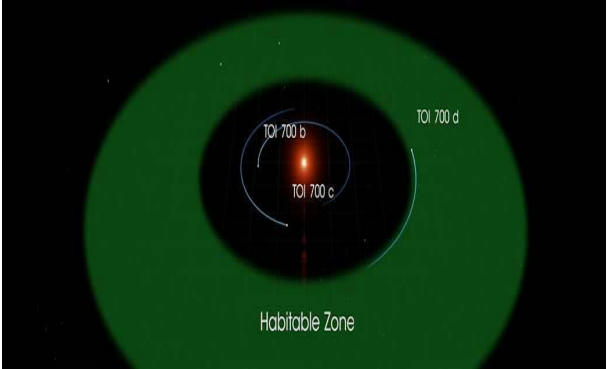Table of Contents
Context
- NASA has reported the discovery of an Earth-size planet.
- Named as TOI 700 d, orbiting its star in the “habitable zone”.
Goldilocks Zone

- A habitable zone, also called the “Goldilocks zone”, is the area around a star where it is not too hot and not too cold for liquid water to exist on the surface of surrounding planets.
TOI 700 D

- The newest such planet was found by NASA’s Transiting Exoplanet Survey Satellite (TESS) mission.
- The star, TOI 700, is an “M dwarf” located just over 100 light-years away in the southern constellation Dorado.
- M-dwarf Star
- M dwarf or M-type star, also called Red Dwarf Star are the most numerous type of star in the universe and the smallest type of hydrogen-burning star.
- These have masses from about 0.08 to 0.6 times that of the Sun.
- In the Milky Way Galaxy, about three-fourths of the stars are red dwarfs.
- However, the TOI 700 star system is unlike the solar system in that all three planets detected so far are thought to be tidally locked to their star.
- Though further measurements from ground-based observatories are needed to confirm, the scientists estimate that the inner and outer planets are rocky, and the middle planet is a gas planet.
- Since TOI 700 d is tidally locked to its star and has a never-ending day and night, there is likely a stark temperature difference between the two sides. So the planet’s cloud formations and wind patterns may be strikingly different from Earth’s.
- The closest potentially habitable planet to the solar system is Proxima Centauri b in the nearest star system, which is just 4.2 light years away. Others within 20 light years include Teegarden’s Star in Aries, Luyten’s Star in Canis Minor, Wolf 1061c in Ophiuchus, and Kapteyn’s Star in Pictor.
- This discovery is also one of the last for NASA’s Spitzer Space Telescope, which launched back in 2003. “Confirming the planet’s size and habitable zone status is another win for Spitzer as it approaches the end of science operations this January,”
- K2-18b: Potentially Habitable Planet
- Scientists have found signatures of water vapour in the atmosphere of K2-18b.
- K2-18b is the only planet orbiting a star outside the Solar System (exoplanet) that is known to have both water and temperatures that could support life.
- However, K2-18b’s size and surface gravity are much larger than Earth’s. Its radiation environment, too, maybe hostile.






















 WhatsApp
WhatsApp